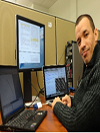
Douglas Santos Rodrigues Ferreira
Federal Institute of Rio de Janeiro
Brazil
Title: On the agreement between small-world-like OFC model and real earthquakes
Biography
Biography: Douglas Santos Rodrigues Ferreira
Abstract
Despite all the existing knowledge about the production of seismic waves through slips on faults, much remains to be discovered regarding the dynamics responsible for these slips. Aiming to contribute to the understanding of earthquake dynamics, in this paper we implemented simulations of the model developed by Olami, Feder and Christensen (OFC model), which incorporate characteristics of self-organized criticality (SOC) and has played an important role in the phenomenological study of earthquakes, because it displays a phenomenology similar to the one found in actual earthquakes. We applied the OFC model for two different topologies: Regular and “small-World”, where in the latter the links are randomly rewired with probability p. In both topologies, we have studied the distribution of time intervals between consecutive earthquakes and the border effects present in each one. In addition, we also have characterized the influence that the probability p produces in certain characteristics of the lattice and in the intensity of border effects. Furthermore, in order to contribute the understanding of long-distance relations between seismic activities, we have built complex networks of successive epicenters from synthetic catalogs produced with the OFC model, using both regular and small-World topologies. In our results, distributions arise belonging to a family of non-traditional distributions functions, which agrees with previous studies using data from actual earthquakes. Our results reinforce the idea that the Earth is in a critical self-organized state and furthermore point towards temporal and spatial correlations between earthquakes in different places.
